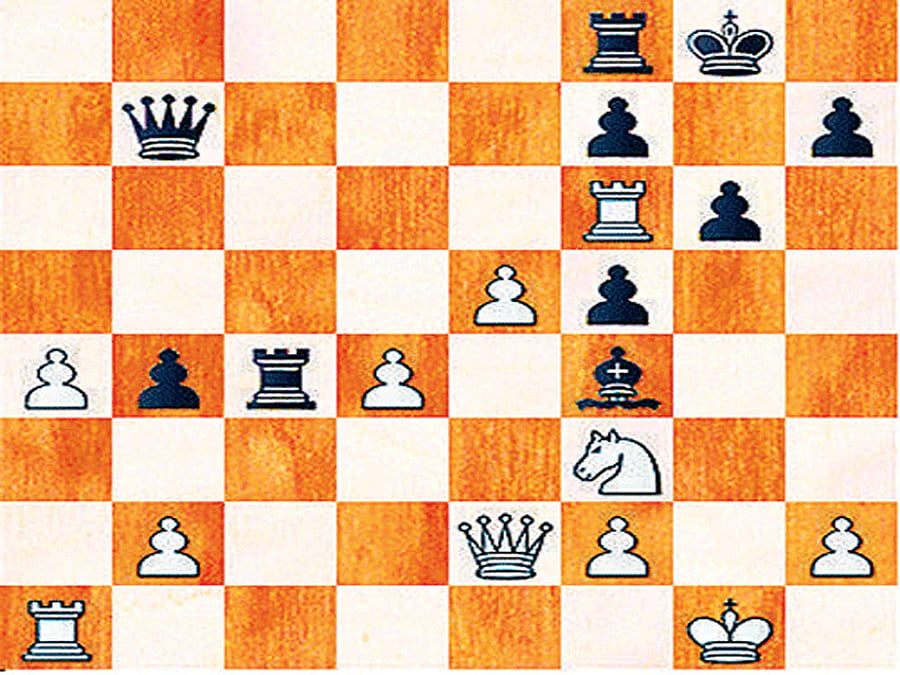
Miscalculations most often are a result of missing out moves and can bring an abrupt end to the game which might appear balanced. Generally, lack of time or at times assuming that a sequence is forced lead to a player going awry in his train of thoughts.
In the game which follows, White appears to be crumbling while approaching the first time control. A few inaccurate moves pushes White on to the backfoot and then he probably misses capture by a queen in a sequence where he wrongly assumes a few forced exchanges.
White: Lars Bo Hansen (2560) – Black: Joerg Hickl (2570)
Polanica Zdroj, 1993
Irregular Queen Pawn Opening
1.d4 .d6 2.Nf3 Bg4 3.e4 Nf6 4.h3
If 4.Nc3 e6 5.h3 Bh5 6.Bd3 Be7 7.Be3 c6
4...Bh5 5.Bd3
5...e6 6.c4. White can play 6.Nc3
6. ..Nc6
Already not a very popular opening, the novelty comes in rather early Previous continuations was6...Be7 7.Nc3 Nc6 8.Be3 0–0 9.Qe2 Bg6 10.Rd1 d5 11.cxd5 exd5 12.e5 Ne4 13.0–0 Qd7 14.Bc1 f5 15.Nxd5
7.Be3. White also had more interesting looking options like 7.g4 Bg6 8.Nc3 d5 9.cxd5 exd5 10.e5 Ne4
7...Bxf3 8.Qxf3 g6. Black can aim for equality with 8. ..e5 9.d5 Nd4
9.Na3 Bg7 10.Nc2 0–0 11.0–0 a5 12.Qe2
White can retreat all the way back to 12.Qd1 Qe7. If 12.a3 a4 13.Rad1 Nd7
12...Nd7. Black wants to push the central pawn to e5
13.f4. An aggressive pawn push? White can play the solid 13.Qd2 or 13.Rad1
13...Nb4
Black can look at 13...e5 14.d5 (14.fxe5 dxe5 15.d5 Nd4 16.Qf2 Nc5 17.Rad1 f5) 14...Nd4 15.Nxd4 exd4 16.Bd2 Nc5
14.a3
If 14.Nxb4 axb4 15.Qd2 (15.f5 15...exf5 16.exf5 c5) 15...c5 16.dxc5 Nxc5
14...Nxd3. If 14...Nxc2 15.Bxc2 c5 16.Qd2 cxd4 17.Bxd4 Bxd4+ 18.Qxd4 Qb6
15.Qxd3 a4. Worth a look is the aggressive looking 15. ..f5
16.Rad1 Qe7 17.Bf2
If 17.f5 exf5 18.exf5 Rae8
17...Rfd8 18.Qe2 Nb6 19.Ne1
White could have tried 19.c5 Nd7 (19...dxc5 20.dxc5 Nd7 21.c6 bxc6 22.e5) 20.c6 bxc6 21.Nb4 Nb8 22.Qc2
19...Bh6 20.Bg3. If 20.Be3 f5
20...Re8 21.Nf3 f5 22.Bh4. If 22.exf5 exf5 And if 22.e5 d5 23.c5 Nc4 24.Nd2
22...Qd7 23.c5
If 23. exf5 23...exf5
23...fxe4 24.Nd2
If 24.Qxe4 Nd5 25.Bg5 Bg7
24...e3
If 24...Nd5 25.Nxe4 Rf8 26.Bg5 Bg7
25.cxb6 exd2 26.bxc7 Qxc7 27.Rxd2 Rac8 28.Qf3 Rf8 29.Qe4 Rce8 30.Bg3 Qb6 31.Kh1 d5 32.Qd3 Qa6 33.Qf3
If 33.Qxa6 bxa6 34.Rc2 Rc8 35.Rfc1 Rxc2 36.Rxc2 Bxf4 37.Bxf4 Rxf4 38.Rc6 Kf7
33...Rf6 34.Re2
If 34.Rdf2 Ref8 35.Qe3
34...Ref8 35.Qe3
Not the right move. Better is 35.Qg4 keeping threats alive on King-side
35...g5 36.Ref2
Another wrong move! White can try 36.f5 or 36.Bf1
36. ..gxf4 37.Bxf4
This time not just a wrong move but a big blunder in apposition which has been deteriorating!
37. ..Rxf4 38.Qg3+
If 38.Rxf4 Qxf1+
38...Kh8 39.Rxf4
Diagram 1
39. ..Qxf1+
White probably may have missed this move during calculations, especially since the first time control was approaching
40.Rxf1 Rxf1+
If 40...Rxf1+ 41.Kh2 Bf4
0–1
Diagram 2
Black to play and checkmate
1... Bg2+ 2.Ke1 Bf2 checkmate.
